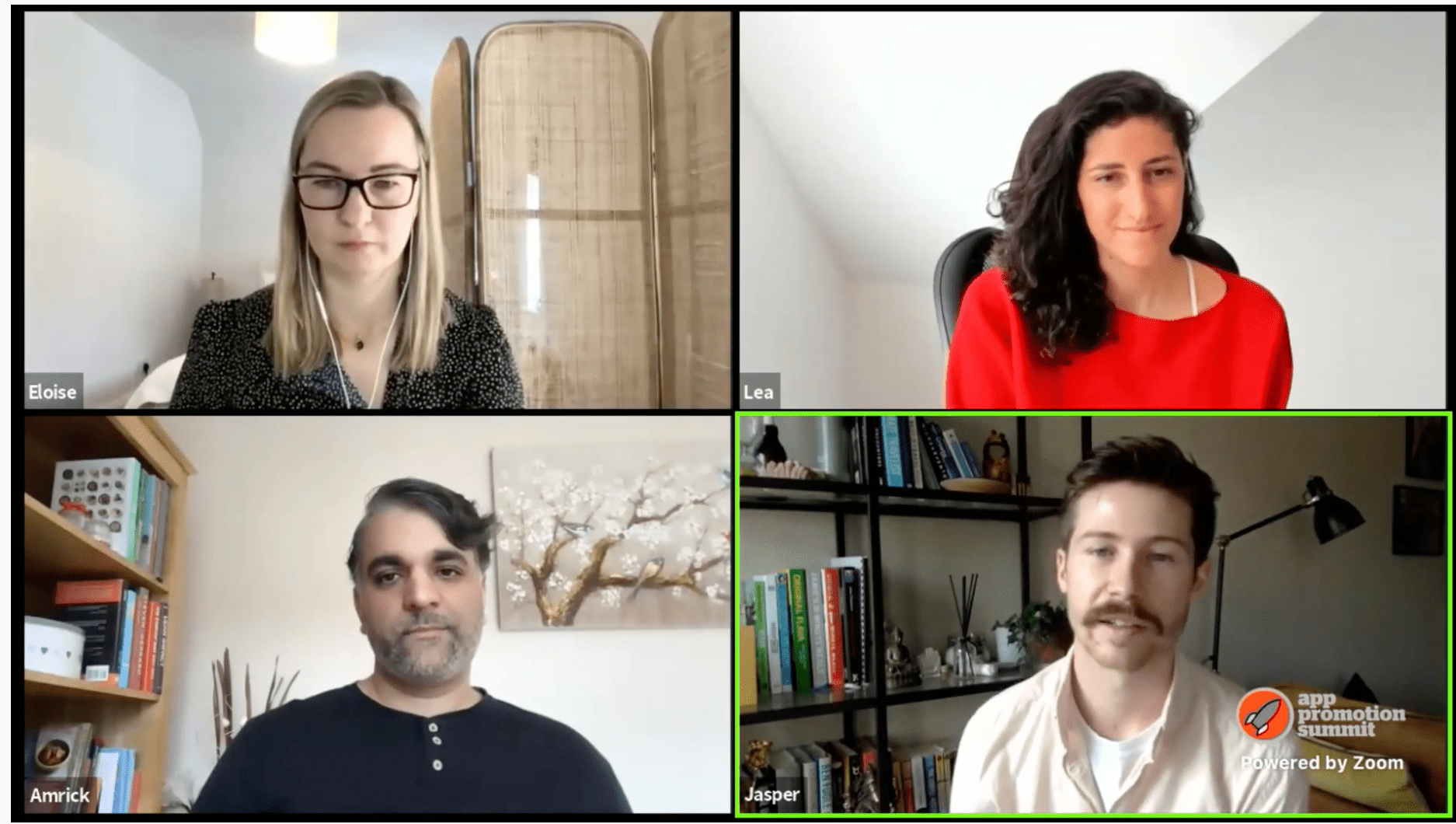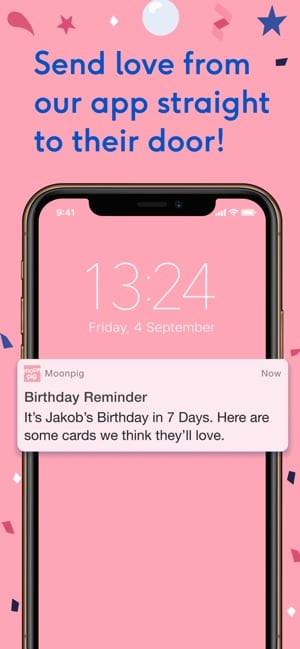With much of the world unable to shop in-store like it used to, brands were forced to adapt over the past year and the old adage held true: necessity breeds invention. Out of the necessity to go digital, many brands are looking at app development to enhance their customer experience.
And, with the increased interest, app development has evolved.
As part of App Promotion Summit’s APS London (WFH), Iterable’s Senior Director of Customer Success, Eloise Shuttleworth had the opportunity to chat with experts in the field to get their insights on how app development and app engagement have changed over the past year.
The panel included Lea Samrani, Product Lead at Uptime, a quick-learning platform; Amrick Chauhan, Lead Product Manager at Which?, a consumer information non-profit; and Jasper Law, Senior Product Manager at Moonpig, a personalized greeting card company.


Eloise Shuttleworth (top left), Lea Samrani (top right), Amrick Chauhan (bottom left) and Jasper Law (bottom right).
Here are some of the key takeaways from their conversation.
Why Have an App?
Apps can create a unique customer experience compared to a mobile or desktop site. Not only is communication through apps different, but the way customers interact with apps is vastly different from how they interact with a website.
1. Push notifications can “cut through the noise of emails.”
In addition to separating your brand from the overwhelming tidal wave of emails customers receive, Jasper also mentioned that push notifications should serve a purpose.
Moonpig sends customers push notifications about upcoming family members’ birthdays. These push notifications are personalized and directly tied to Moonpig’s product, allowing users to go from the push into the app to buy a card.
It never hurts to get on grandma’s good side.
2. You can engage with users differently on an app versus a mobile site.
Amrick pointed out one example of this: hardware integrations. An app can seamlessly use the phone’s camera to scan products or take photos, providing an additional layer of value to the consumer. Little changes like these can take the experience up a notch.
3. Having an app on the users’ home screens creates a deeper relationship with consumers.
Amrick also mentioned that because the average person unlocks their phone up to 150 times a day, having your brand’s logo on users’ home screens can prime them and create brand familiarity. Customers are more likely to use your brand in the future because they recognize your logo.
Push notifications can set your brand apart through personalization and overall experience. While customers are used to getting emails, having helpful push notifications tailored to their experience creates a bond between your brand and your app users.
Acquisition vs. Retention: Which Is the Focus for App Development?
Acquiring new app users can be costly, especially since prompting a download can be challenging. However, for app development specifically, focusing on retention can help compensate for that initial acquisition cost.
1. There’s no point in acquiring users if people don’t stay on the app.
If you’re not creating an experience that has customers engaged in the app—which for Uptime is synonymous with their product—why would you continue to invest in bringing new people into that environment? “Retention is a latent indicator of success,” said Lea. Identify your app’s value drivers and push those to the forefront to maintain engagement.
2. Defined early metrics determine what will trigger future retention.
For Uptime, that metric is completing a “hack.” A hack is a five-minute story to help a member easily understand a topic. Lea’s team learned that if customers complete a hack their retention rate is much higher because they’re experiencing the full product as it’s meant to be experienced. Understanding which interactions with your app lead to further engagement is step one to increasing retention.
Retention efforts focus on the user’s lifetime value (LTV). Once users have the app on their phone, the priority is keeping them engaged via individualized communication and experiences. Getting a new user to download the app isn’t the finish line—it’s the starting line.
Is There Value in Gamifying Your App?
Gamification can be helpful when it comes to getting your users to engage with your app. With that said, it has to make sense for the ways in which users move through your app and brand experience.
1. It’s less about gamifying the app and “more about creating a rewarding experience.”
With Uptime, for example, the goal is to reward people for learning something. Gamifying for gamification’s sake is unnecessary if it doesn’t add value to the user’s experience.
2. There’s value in creating an emotional experience.
Jasper pointed out that there’s so much delight and playfulness in mobile games, but e-commerce can often be so boring.
So at Moonpig, they added confetti to the purchase confirmation page. Jasper noted this could be seen as “naff” (a.k.a. tacky or unfashionable for us non-Brits), but it adds something to the user’s experience and creates an emotional response.
Eliciting emotion creates a connection with your users. With gamification, customers may become proud of themselves when they achieve a task or happy when they see confetti after making a purchase. The emotion tied to gamification is a driving force behind app engagement.
How Can A Personalized Customer Experience Influence App Success?
A personalized customer experience is all about understanding each user as an individual and piecing together a 360° view for every one of them. If a shopper is using your app, the app is part of their overall experience.
1. Personalization is the number one priority.
Moonpig has the ability to customize the user experience based on the vast amount of customer data it’s collected over the past 20 years.
However, Jasper said the focus right now is simply personalizing the app experience based on what the customer did during their last session. Because apps are often used in multiple, short sessions, Moonpig’s goal is “connecting multiple, snackable sessions.” Just because you have the data, doesn’t mean it will all be useful as you iterate through different strategies.
2. Gathering data and then dissecting it to understand what it’s telling you about the customer journey is key.
Jasper said, “We know that returning customers tend to take a bit longer than new customers…I think [returning customers] are browsing more, maybe a new customer comes to us because they’re like, ‘Oh crap! I need to get a card instantly.’”
3. Focus on finding a balance between quick wins and bigger undertakings to tailor your app to what your customers really need.
Customer feedback will likely result in finding bugs and product suggestions. Not only that, customer feedback can provide a wealth of insights into what your customers are looking for from your product or the overall experience. Amrick recommends organizing different types of customer feedback by priority to avoid being overwhelmed while still making strides towards personalization.
The customer journey is specific to your brand and how your customers interact with your brand. Collecting data is a helpful first step, but the key to creating a personalized experience is understanding what to do with that data.
How App Development Enhances the Personalized Experience
In the past year, brands have accelerated their digital transformation and, as a result, we’re seeing digital channels becoming crucial parts of the customer journey. To deliver a more personalized experience, brands need to compile a holistic view of their customers as they interact with the brand at different touchpoints.
True personalization requires cross-channel marketing to meet users where they are and deliver a seamless experience.
With apps allowing for a unique way of communicating with users, the right app development can create a long-lasting connection between the consumer and the brand.
Looking to watch the full session? Check it out.






























